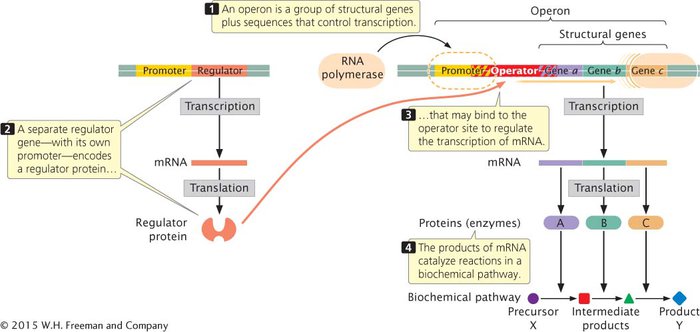Operon Structure
The organization of a typical operon is illustrated in Figure 12.2. At one end of the operon is a set of structural genes, shown in Figure 12.2 as gene a, gene b, and gene c. These structural genes are transcribed into a single mRNA, which is translated to produce enzymes A, B, and C. These enzymes carry out a series of biochemical reactions that convert precursor molecule X into product Y. The transcription of structural genes a, b, and c is under the control of a promoter, which lies upstream of the first structural gene. RNA polymerase binds to the promoter and then moves downstream, transcribing the structural genes.

A regulator gene helps to control the expression of the structural genes of the operon by increasing or decreasing their transcription. Although it affects operon function, the regulator gene is not considered part of the operon. The regulator gene has its own promoter and is transcribed into a short mRNA, which is translated into a small protein. This regulator protein can bind to a region of the operon called the operator and affect whether transcription can take place. The operator usually overlaps the 3′ end of the promoter and sometimes the 5′ end of the first structural gene (see Figure 12.2).
CONCEPTS
Functionally related genes in bacterial cells are frequently clustered together in a single transcriptional unit termed an operon. A typical operon includes several structural genes, a promoter for those structural genes, and an operator to which the product of a regulator gene binds.
 CONCEPT CHECK 3
CONCEPT CHECK 3
What is the difference between a structural gene and a regulator gene?
Structural genes are transcribed into mRNA, but regulator genes are not.
Structural genes have complex structures; regulator genes have simple structures.
Structural genes encode proteins that function in the structure of the cell; regulator genes carry out metabolic reactions.
Structural genes encode proteins; regulator genes control the transcription of structural genes.
d